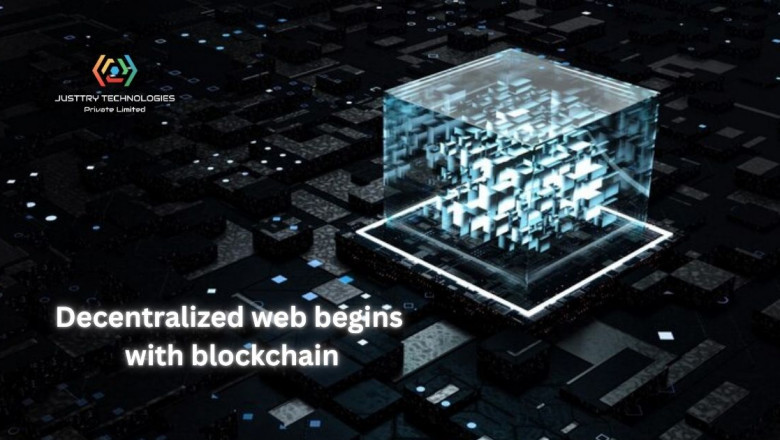views
1. Introduction
Welcome to the next era of the internet—Web3. It’s more than just a buzzword. It’s a whole new world where users gain control, data is decentralized, and privacy is prioritized. But what’s fueling this revolutionary change? You guessed it—blockchain technology. Let’s take a deep dive into how blockchain is reshaping the internet as we know it.
2. What Is Web3?
Web3 is the third generation of the internet. Unlike Web1 (read-only) and Web2 (interactive but centralized), Web3 is decentralized. It empowers users instead of corporations, thanks to technologies like blockchain that remove the need for intermediaries.
3. A Quick Look at Blockchain Technology
Blockchain is a distributed ledger system. It keeps data secure, transparent, and immutable across a network of nodes. Each transaction is recorded in blocks, and once confirmed, it can’t be changed—making it ideal for the trustless environment of Web3.
4. Understanding the Backbone — Blockchain Explained
The Core Principles of Blockchain
Decentralization
No central authority controls the system. Users interact peer-to-peer, which boosts transparency and removes single points of failure.
Transparency and Immutability
Every transaction is publicly verifiable and cannot be altered once validated. That’s trust without needing to trust anyone!
How Blockchain Networks Operate
Every node in a blockchain network stores a copy of the ledger. When a new block is created, it’s verified by consensus mechanisms like Proof of Work or Proof of Stake before being added.
5. Web3 and Blockchain — A Powerful Partnership
Why Blockchain Is Essential for Web3
Without blockchain, Web3 would still rely on centralized servers. Blockchain allows for true ownership of data, secure identity management, and self-executing smart contracts.
The Transition from Web2 to Web3
Web2 is dominated by tech giants like Google and Meta. Web3 shifts power back to the users, with decentralized apps (dApps) and platforms that run on transparent protocols.
6. Key Benefits of Blockchain Technology in Web3
User Empowerment and Data Ownership
Blockchain gives users control over their own data. Imagine owning your digital identity like you own your house.
Decentralized Identity
Say goodbye to logging into sites using your email. Your wallet becomes your identity, making for safer, seamless logins.
Enhanced Security and Trust
Thanks to blockchain’s immutable nature, data breaches are drastically reduced. Users no longer need to trust corporations to keep their info safe.
7. Use Cases of Blockchain in Web3
Decentralized Finance (DeFi)
DeFi allows people to borrow, lend, and trade assets without banks.
Real-World Example: Uniswap
Uniswap is a decentralized exchange where users can swap crypto tokens without middlemen, using automated smart contracts.
Decentralized Autonomous Organizations (DAOs)
DAOs are internet-native organizations governed by code, not CEOs. Decisions are made through token-holder voting.
NFTs and Digital Ownership
Non-fungible tokens prove ownership of unique digital items—from art to music to virtual real estate.
Web3 Social Platforms
Platforms like Lens Protocol let users own their content and move it across apps without losing followers.
8. The Role of Blockchain in Web3 App Development
Smart Contracts as the Backbone
Smart contracts are self-executing programs that run on the blockchain. They eliminate the need for third-party enforcement.
Real-Time Data Integrity
Because data is recorded on the blockchain, it's tamper-proof and trustworthy—great for apps that need transparency.
Developer Opportunities and Challenges
Web3 app development opens new doors but comes with learning curves—especially around blockchain infrastructure and gas fees.
9. Use of Blockchain Technology in Financial Services
Transparent Transactions
Every transaction on a blockchain is traceable, making auditing and compliance easier than ever.
Elimination of Intermediaries
No need for middlemen like brokers or banks. This reduces costs and speeds up transactions.
Cross-Border Payments
Sending money across borders is faster and cheaper with blockchain-based stablecoins and crypto networks.
10. Real World Examples of Web3 and Blockchain Synergy
Ethereum Ecosystem
Ethereum is the go-to platform for Web3 development. It supports smart contracts and hosts countless dApps.
Polkadot and Interoperability
Polkadot connects different blockchains, allowing them to share data and assets seamlessly.
Filecoin for Decentralized Storage
Filecoin stores data across a decentralized network instead of centralized servers, giving users full control.
11. Security Aspects of Blockchain in Web3
Can Blockchain Be Hacked?
It's extremely difficult, but not impossible. A hacker would need to control over 51% of the network, which is highly improbable for well-established blockchains.
Measures That Protect Blockchain Systems
Cryptographic hashing, consensus mechanisms, and decentralization make blockchain one of the most secure digital infrastructures.
12. The Future of Web3 Development
Scalability Solutions
Tech like Layer 2 rollups and sharding are making blockchain faster and cheaper to use.
Interoperability Between Networks
Projects like Cosmos and Polkadot are building bridges between blockchains for a more connected ecosystem.
13. Challenges and Solutions
Scalability and Speed
Solution: Implementing Layer 2 and optimizing consensus algorithms.
Regulatory Issues
Solution: Creating hybrid solutions that balance decentralization with compliance.
Adoption Barriers
Solution: Better UX and education to help users and developers transition smoothly.
14. Final Thoughts
Blockchain isn’t just a piece of tech—it’s the foundation of Web3. From secure identities and transparent financial systems to decentralized apps and user empowerment, the use of blockchain technology is redefining our digital future. So, as the world shifts toward decentralization, are you ready to embrace the Web3 revolution?






















Comments
0 comment